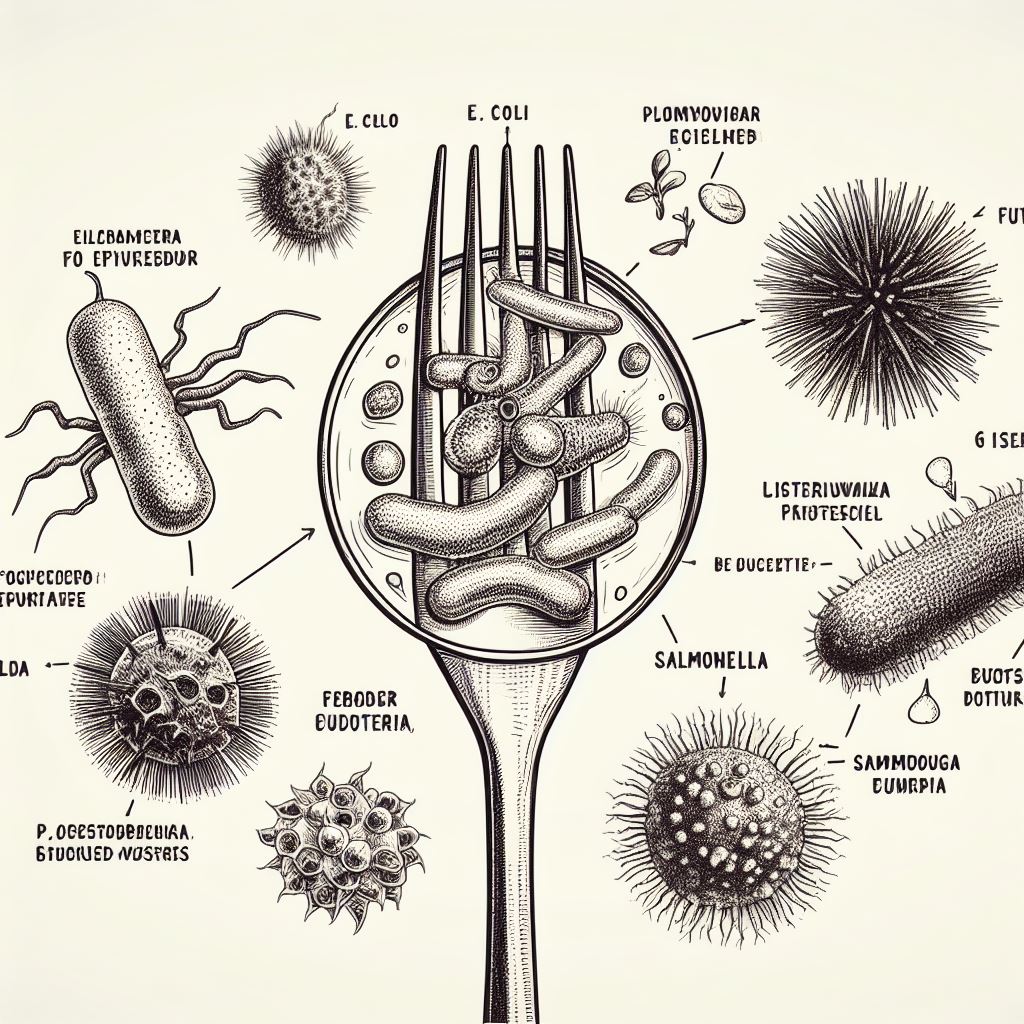
Unveiling the Microbial Magic: The World of Food Bacteria
Food bacteria are an essential and often underappreciated aspect of our culinary world. These microorganisms, both beneficial and potentially harmful, play a crucial role in shaping the flavors, textures, and safety of the foods we consume.
The Diversity of Food Bacteria
The world of food bacteria is incredibly diverse. It’s teeming with thousands of species, each with its unique characteristics and roles in the realm of food production, preservation, and consumption. Among the most common types are lactic acid bacteria, such as Lactobacillus and Bifidobacterium, which contribute to the fermentation of dairy products, sourdough bread, and certain pickled vegetables. On the other hand, species like Escherichia coli, Salmonella, and Campylobacter can be harmful when present in food, causing foodborne illnesses.
The Role of Food Bacteria
- Fermentation: One of the most celebrated functions of food bacteria is their role in fermentation. This process is pivotal in the creation of a multitude of foods, including yogurt, cheese, kimchi, and sauerkraut. Bacteria convert sugars into lactic acid or other organic acids, which not only preserve the food but also impart distinctive flavors and textures.
- Flavor Enhancement: Bacteria are the unsung heroes behind some of the most beloved flavors in the culinary world. The complex aroma and taste of cheese, for example, are largely the result of bacterial activity during the aging process. Similarly, sourdough bread acquires its tangy flavor through the fermentation of naturally occurring yeasts and lactic acid bacteria.
- Preservation: Food bacteria play an essential role in preserving certain foods. For instance, the presence of bacteria can create an acidic environment, which inhibits the growth of harmful microorganisms, making food safe for long-term storage. This is evident in fermented foods like pickles, as well as in foods like sausages and salami.
- Probiotics: Some food bacteria offer health benefits. Probiotic bacteria, such as certain strains of Lactobacillus and Bifidobacterium, are intentionally added to foods like yogurt and kefir. These beneficial bacteria can help maintain a healthy gut microbiome and support digestive health.
Food Safety and Bacteria
While food bacteria offer numerous benefits, the presence of pathogenic bacteria in food can pose significant risks to human health. Contaminated food can lead to foodborne illnesses, which can range from mild gastrointestinal discomfort to severe, life-threatening conditions. This highlights the critical importance of food safety measures such as proper handling, storage, and cooking to prevent the proliferation of harmful bacteria.
In recent years, there has been a growing emphasis on understanding and controlling foodborne pathogens. Advances in food safety technology and practices have led to improved detection methods and more stringent regulations. These measures help ensure that foodborne illness outbreaks are minimized and that consumers can trust the safety of the food they purchase.
Here is a list of different types of food bacteria:
- Lactobacillus: These are commonly found in yogurt and contribute to the fermentation and tangy flavor of dairy products. They are also used in sourdough bread production.
- Bifidobacterium: Another type of bacteria found in yogurt and other fermented dairy products, known for their probiotic benefits.
- Streptococcus thermophilus: Used in yogurt production, they help convert milk sugars into lactic acid, thickening the yogurt and giving it a tangy taste.
- Escherichia coli (E. coli): While some strains are harmless and even beneficial, others can cause foodborne illnesses.
- Salmonella: A common cause of food poisoning, often associated with undercooked or contaminated poultry and eggs.
- Campylobacter: Frequently associated with undercooked poultry and can lead to foodborne illness.
- Listeria monocytogenes: A pathogenic bacterium that can grow at refrigeration temperatures and is often associated with deli meats and soft cheeses.
- Clostridium botulinum: Responsible for botulism, a potentially deadly illness that can occur when consuming improperly canned or preserved foods.
- Lactic acid bacteria (LAB): A group of bacteria that produce lactic acid and are used in the fermentation of various foods, including sauerkraut, pickles, and kimchi.
- Acetobacter aceti: Used in the production of vinegar, converting ethanol into acetic acid.
- Propionibacterium: Found in Swiss cheese, these bacteria produce carbon dioxide gas, contributing to the formation of characteristic holes in the cheese.
- Bacillus cereus: Often found in rice dishes and can cause food poisoning if the rice is not stored or handled properly.
- Pseudomonas: Commonly associated with spoilage in various foods, such as meat, fish, and dairy products.
- Cyanobacteria (Blue-green algae): Sometimes used in the production of nutritional supplements and certain types of foods, like spirulina.
- Helicobacter pylori: Associated with gastritis and stomach ulcers, though not typically found in food.
- Yersinia enterocolitica: Can be found in raw or undercooked pork products and may cause foodborne illnesses.
These are just a few examples of the many different types of bacteria that play various roles in food production, preservation, and safety. Some are beneficial, contributing to the development of specific food products, while others pose potential health risks if not handled or prepared with care.
Why people with low immune systems should be careful about bacteria. mention the listeria diet.
Individuals with weakened immune systems, such as those with autoimmune diseases, organ transplants, cancer patients undergoing treatment, and the elderly, are more susceptible to infections and illnesses. This vulnerability extends to bacteria, making it crucial for them to be extra cautious when it comes to bacterial exposure, including the specific concern of Listeria in their diet.
Here’s why they should exercise extra care:
- Reduced Immune Response: A weakened immune system means the body has a diminished ability to fend off infections. Bacteria that might not cause problems for healthy individuals can become a significant threat to those with low immunity.
- Increased Risk of Infection: People with compromised immune systems are at a higher risk of bacterial infections, which can lead to severe illnesses, hospitalization, or even fatalities.
- Listeria Concern: Listeria monocytogenes is a bacterium known for its ability to thrive at low temperatures, making it a particular concern in refrigerated or ready-to-eat foods. For individuals with weakened immune systems, Listeria can be especially dangerous. Listeriosis, the infection caused by Listeria, can lead to symptoms like fever, muscle aches, nausea, and in severe cases, life-threatening complications like septicemia, meningitis, and fetal infections in pregnant women.
- Pregnant Women: Pregnant women, another group with altered immune responses, should also be cautious as Listeria can harm the fetus. Therefore, it is recommended to avoid certain high-risk foods during pregnancy, like soft cheeses, deli meats, and refrigerated smoked seafood, which can be contaminated with Listeria.
- Dietary Precautions: People with weakened immune systems should follow specific dietary precautions, such as avoiding raw or undercooked eggs and meats, unpasteurized dairy products, and uncooked seafood. They should also steer clear of soft cheeses made from unpasteurized milk and practice meticulous food handling and hygiene to prevent bacterial contamination.
- Regular Handwashing: Maintaining excellent hygiene practices is essential. Frequent handwashing with soap and water, particularly before handling food, can help reduce the risk of bacterial exposure.
- Proper Food Storage: Ensuring that perishable foods are stored at safe temperatures (below 40°F or 4°C) and consumed promptly can prevent bacterial growth, including Listeria.
- Cooking Thoroughly: Cooking foods to safe temperatures is crucial, as it kills harmful bacteria. Using a food thermometer can help ensure that foods like poultry, meat, and seafood are adequately cooked.
Individuals with low immune systems should exercise extra caution when it comes to bacteria, particularly Listeria, in their diet. Taking preventive measures, adhering to a safe and balanced diet, and practicing good food safety and hygiene can significantly reduce the risk of bacterial infections and help protect their health.
The Listeria Diet and What Foods One Should Avoid.
The Listeria diet, often referred to as a Listeria avoidance diet, is a dietary approach recommended for individuals at a higher risk of Listeria infection, including pregnant women, those with compromised immune systems, and the elderly. Listeria monocytogenes is a bacterium that can cause serious illness, particularly in these vulnerable populations. To reduce the risk of Listeria infection, individuals should be mindful of the foods they consume and consider the following dietary guidelines:
List Of Foods To Avoid On a Listeria Diet:
- Unpasteurized Dairy Products: Raw milk and products made from unpasteurized milk, such as soft cheeses (e.g., Brie, Camembert, feta, queso blanco, queso fresco, and blue-veined cheeses), can carry Listeria. Opt for pasteurized dairy products instead.
- Refrigerated Smoked Seafood: Ready-to-eat smoked seafood, like smoked salmon, trout, mackerel, and kippered fish, can be contaminated with Listeria. Canned or shelf-stable smoked seafood is a safer alternative.
- Prepackaged Deli Meats and Hot Dogs: These products are at risk of Listeria contamination if not handled or stored properly. If you choose to consume them, heat them to a safe temperature to kill any potential bacteria.
- Uncooked or Raw Sprouts: Raw sprouts, including alfalfa, clover, and radish sprouts, can harbor bacteria like Listeria. Cooking sprouts thoroughly before consumption is a safer option.
- Raw Eggs and Foods Made with Raw Eggs: Raw or undercooked eggs can contain Listeria, so avoid dishes like homemade mayonnaise, aioli, and certain salad dressings that rely on raw eggs. Opt for pasteurized egg products if needed.
- Refrigerated Pâté and Meat Spreads: Listeria can thrive in refrigerated pâtés and meat spreads, so it’s advisable to choose shelf-stable or canned options instead.
Dietary Precautions:
- Proper Food Handling: Ensure that you follow strict food safety practices. Wash your hands, utensils, and surfaces before handling food. Keep perishable foods refrigerated at or below 40°F (4°C).
- Thorough Cooking: Cooking food to safe temperatures is key to eliminating Listeria and other harmful bacteria. Use a food thermometer to ensure that meats, poultry, seafood, and eggs are cooked to recommended internal temperatures.
- Reheating Deli Meats: If you want to consume deli meats, heat them until they are steaming hot, as this can help kill any Listeria bacteria.
- Avoid Cross-Contamination: Prevent cross-contamination by keeping raw meats, poultry, and seafood separate from ready-to-eat foods and ensuring thorough washing of cutting boards and utensils.
- Safe Fruits and Vegetables: Wash fresh produce thoroughly under running water and, if needed, use a brush for items with rinds, like melons. Store fruits and vegetables in the refrigerator to minimize the risk of bacterial growth.
It’s important to note that while Listeria is a potential concern, the risk of infection is relatively low, and most people can enjoy a balanced diet without significant dietary restrictions. However, for individuals at higher risk, following a Listeria avoidance diet and practicing proper food safety can help reduce the risk of infection and ensure their health and the health of their unborn child or other vulnerable individuals.
Conclusion
Food bacteria are an integral part of our culinary world, shaping the flavors and textures of the foods we love. From the tangy richness of cheese to the crisp bite of pickles, bacteria play a pivotal role in food production, preservation, and flavor enhancement. However, we must also remain vigilant when it comes to food safety, as harmful bacteria can pose serious health risks. By understanding the balance between the benefits and potential dangers of food bacteria, we can fully appreciate their place in our gastronomic journey and continue to enjoy a rich and diverse world of flavors.
#foodbacteria #foodpoisoning #listeriadiet #salmonella #ecoli #foodsafety #lowimmunesystem
ADVERTISEMENTS


Andrew Jones is a seasoned journalist renowned for his expertise in current affairs, politics, economics and health reporting. With a career spanning over two decades, he has established himself as a trusted voice in the field, providing insightful analysis and thought-provoking commentary on some of the most pressing issues of our time.









